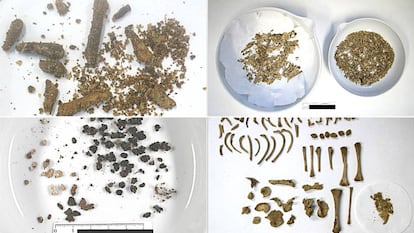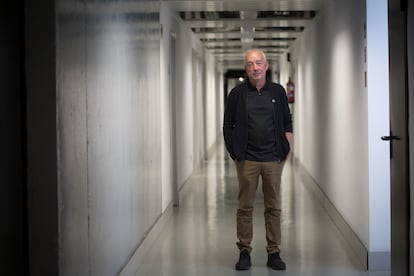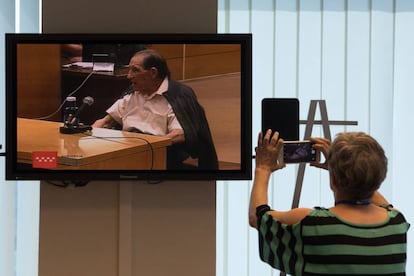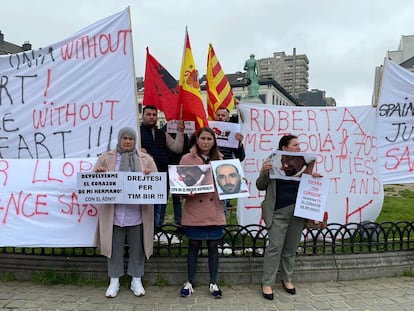Antonio Alonso, geneticist: ‘I do not believe that there was a plot to abduct newborns from Spanish public hospitals during democracy’
The director of the National Institute of Toxicology and Forensic Sciences denies the existence of an abduction ring involving 300,000 newborns in Spain after investigating hundreds of cases


The figure of 300,000 stolen babies in Spain emerged in 2011 from statements to the press by lawyer Enrique Vila, owner of a law firm specializing in the search for biological relatives. Vila proclaimed the existence of “up to 300,000 thefts,” an estimate of his own, but now qualifies that he was actually referring to the hypothetical number of people registered with false biological parents, a concept that would include irregular adoptions of knowingly surrendered children. Vila’s office began to receive calls non-stop. The Basque Country, the epicenter of the phenomenon, immediately investigated 300 reports of newborn abductions with a dedicated police unit, but did not find “even reasonable indications,” in the words of the senior prosecutor. Geneticist Antonio Alonso, director of the National Institute of Toxicology and Forensic Sciences, recalls that the Prosecutor’s Office has investigated more than 2,000 reports of alleged baby thefts, of which around 500 went to trial. Faced with indications of abduction, scientists went to cemeteries and exhumed more than a hundred infant coffins. The deceased babies were there.
Alonso receives EL PAÍS to talk about the imminent inauguration of the national DNA Bank of Victims of the Civil War and the Dictatorship. The tool will help identify remains from mass graves, but will also include the genetic profiles of people allegedly affected by baby thefts. The issue is generating interest around the world. One of the most widely read stories in The New York Times last year was a report on the “tens of thousands” of Spanish newborns “secretly taken from hospitals and sold to wealthy Catholic families.” Alonso, sitting in his office at the Institute’s headquarters in Las Rozas, explains his scientific findings.
Question. How many confirmed cases of stolen babies are there in Spain?
Answer. To my knowledge, there are no confirmed case of stolen babies, meaning a modus operandi in which the death of a baby was simulated, in a private or pubic hospital, to steal it and sell it to whatever organized crime group. It’s quite the opposite. In the first case of stolen babies that brought a gynecologist, Dr. Eduardo Vela, to the stand, it was proven that the complainant, Inés Madrigal, was not a stolen baby. Her mother, single, made a ‘donation’ of the baby at a private clinic [and Dr. Vela irregularly registered the girl as the biological daughter of a sterile woman]. That is a crime, obviously, but it is not newborn abduction.
Q. Many people think that stolen babies in Spain have not been investigated, but you have even exhumed bodies. How many coffins have been opened?
A. Yes, the Prosecutor’s Office has done important work on more than 2,000 complaints. Unfortunately, the issue of stolen babies is complex due to the difficulty of investigating. Most babies who died in hospitals in the 1950s, 1960s and 1970s went to a nursery cemetery, which usually involved burial, often in mass graves. In 117 of 120 exhumations we managed to recover bone remains of newborns: 97%. We were able to obtain DNA in 90 cases and in 90% we were able to identify the babies as children of the parents who were looking for them, thus closing those investigations.
Q. How did the families react?
A. Most families said: “Great, this uncertainty we had is over.” Regardless of the reality, you have to put yourself in the position of parents, who receive information that there were 300,000 stolen babies at a time when their baby died. It triggers great uncertainty: “Did my baby die or have they lied to me, like they say they have lied to 300,000 families?” When we were able to prove that the babies had died, some parents didn’t believe it. No matter how much scientific evidence we showed them that their children were there, they would not believe it. It really impacted us: the relatives believed that we were lying to them.
It was said that a baby cannot just disappear, but of course a baby can disappear, disintegrate, completely degrade due to different effects of soil, acidity, humidity, vermin etc.
Q. Did they find any empty coffins?
A. There were three cases in which we did not find bone remains in the coffin, but fetal hairs, the clamp of the umbilical cord, a stained surgical cloth were found... Forensic evidence indicates that there was a corpse there of which there were no longer any remains. There is a very important element: it was said that a baby cannot just disappear, but of course a baby can disappear, disintegrate, completely degrade due to different effects of soil, acidity, humidity, vermin, etc. Our anthropology laboratory has recovered tiny remains, which we know are collagen and attributable to the remains of a newborn, but, morphologically, they cannot be identified without thorough investigation. And that is what happened at the beginning: there was a private initiative that carried out the exhumations and did not have the technical knowledge to do this.

Q. You sent that report of the 120 exhumations to the European Parliament.
A. That analysis revealed to us that something was happening here. It is very striking that all these cases have the same modus operandi: “The child was born in good health, but a few hours later they told me that he had become very sick and had died. They didn’t show me the body.” That is to say, the memory of all these people is the same, probably fueled by certain poorly contrasted news, so to speak. I believe that an important cognitive bias has been generated: if they tell me that at the time there were 300,000 cases, why not me?
Q. In 1976, nine babies died for every 1,000 born.
A. And also at that time, in the 1960s and 1970s, the treatment of patients in a hospital was not the same [as today], from a rights, information, and privacy point of view. Now it would be unthinkable [not to let you see your baby’s body]. We must improve knowledge of the magnitude of the problem, because I believe that a large number of the cases, at least with that modus operandi, did not exist. I believe that there were an enormous amount of irregular adoptions, like that of Inés Madrigal, which was not an abduction of newborns.
Q. Forensicist Francisco Etxeberria, who is a reference point in the exhumation of graves from the Spanish Civil War, affirms that there were no thefts of babies in hospitals and that it is a case of collective psychosis. Do you believe this?
A. We have to be tremendously respectful of people who suffer from a situation of uncertainty and believe that something happened that perhaps did not happen. There are certain cases, indeed, in which we have presented genetic evidence to the parents and they did not believe it. They think we are lying to them. I was very shocked that they questioned our work, when it is so evident. In some cases you think that the DNA test should not even have been done, because there is a report from a public hospital that shows a pathology incompatible with life. Some parents donated their deceased daughter’s liver to a hospital for analysis, and 30 years after doing so this has led them to say “my daughter has been stolen.”
Q. There are reports of babies stolen from public hospitals after the return to democracy, in the 1980s and 1990s.
A. One of the cases I was talking about was from the 1990s, in a public hospital in a Spanish city. There was an initial error from another laboratory, which obtained three DNA profiles from the newborn’s hair and said that none of them matched that of the mother. But it was an erroneous interpretation, due to contamination in the laboratory. This increases distrust regarding the official body, the National Institute of Toxicology. They see a conspiracy because we are part of the state. I am very sad, but I think that the majority of parents whose deceased child we have been able to identify have received the news very positively.

Q. In the Basque Country, in 2012, the then-regional premier, Patxi López, said on television that there was a plot, a business “well-orchestrated between the doctors, the hospitals, the cemeteries themselves.” The data, then, does not support that.
A. I think not. From my point of view, where perhaps not so much investigation has taken place and where more should be carried out is in certain Francoist institutions, such as the residences for single mothers. Who went there? Well, vulnerable young girls, pregnant, who, due to a cultural, family or economic circumstance, gave up their children. What was done with those children? These residences were normally managed by religious orders. For example, Peñagrande, in Madrid [active between 1955 and 1983]. It is a situation that we would not permit today, with falsehoods in public documents that said the biological mother was the one to whom a baby from a single mother was donated.
Q. In those residences, did mothers consciously give up their children?
A. It’s my understanding that the majority did, but were forced by necessity. So, I think there is no need to make up the story that they had a frozen baby in the hospitals that they showed to the mothers [in order to steal their live baby]. Who comes up with that? It is not easy to do that in a public hospital, that modus operandi does not fit at all. And yet, we do know that in those residences run by the [Franco] regime, there was such trafficking of babies. I think we are blurring the origin of the problem and, therefore, the solution. We are giving false expectations to a lot of [stolen baby] associations that have emerged.
Could it happen? Yes. But was there a newborn abduction mafia? A mafia of gynecologists from public hospitals? Medical teams from many public hospitals are being questioned, without any evidence
Q. It seems that there is a consensus to investigate alleged robberies in public hospitals in the 1980s.
A. There is a political consensus. In principle there is unanimous support for developing the law [on stolen babies], which could not be completed because the legislature ended. However, right-wing parties voted against the Democratic Memory Law. And, if they come to power tomorrow, they will repeal it. I don’t understand it, I really don’t understand it. Faced with the uncertainty of a person who knows that his or her family member was executed and buried and does not know where, the state has to offer support. Given the other uncertainty [that of the alleged stolen babies], of which we are not so certain, we will also have to help, but one way to do it is to transmit what we are finding out. To talk about 300,000 [stolen babies] is to multiply by 10 the figure given by Judge Baltasar Garzón [in 2008] of 30,000 children in religious institutions run by the regime in the 1940s and 1950s. But the complaints that exist now do not come from that era, they have nothing to do with it.
Q. Garzón was referring to “war orphans with dead parents, prisoners, exiles, in hiding or missing,” not to babies stolen from their mothers in a hospital.
A. Indeed, it was more to do with Franco’s post-war repression. Did that happen? Of course. Those 30,000 have now become 300,000 without any scientific basis. The cases reported now are mostly from the 1960s and 1970s, but also from the 1990s and even the 2000s. In the era Garzón was referring to, there was certainly trafficking and theft, but that is not what the associations have asked us to analyze. I will not say that it did not happen, but I will say that we have not seen any cases of the abduction of newborns. I haven’t seen it. Could it happen? Yes. But was there a newborn abduction mafia? A mafia of gynecologists from public hospitals? Medical teams from many public hospitals are being questioned, without any evidence. I do not believe that there was a plot to abduct newborns from public hospitals during democracy. Not one case has been proven.

Q. And in private centers?
A. Probably not in private centers either. I was talking about public hospitals because many of the complaints stem from public hospitals. In certain private clinics, such as San Ramón and Santa Cristina in Madrid, where Dr. Vela [who was found guilty at trial in 2018 of trafficking children during the Franco regime] worked, there were surely irregular adoptions. One has already been proven: that of Inés Madrigal, who was born at the San Ramón clinic. Her mother was single and said: “I’m sorry, but if I can give you the baby it will take away my problem.” What this man did next was trafficking: he told a woman to fake a birth and then he played a role for her by saying that she was the biological mother. That’s outrageous, but it’s not baby theft like the news we’re getting.
Q. The Spanish Ministry of Justice, which finances your institute, has just acquired the Bonaparte computer program, which allows the development of DNA databases to identify corpses and missing persons. What does this tool provide?
A. The idea of the new project is to incorporate DNA profiles, above all, from remains from the different exhumations. Now work is being carried out, fundamentally, on the largest grave in Spain, the Valley of the Fallen, or Cuelgamuros Valley. In many of the crypts there, the columbariums have been broken and there is a significant mix of bones. And, of course, it is very difficult to carry out an archaeological analysis to identify all of these remains. In 1959, when the Valley of the Fallen was inaugurated, all civil governors were asked to exhume everything in cemeteries, ditches, or other places and send it there. That is to say, a first exhumation of the 1936 burials was carried out, by gravediggers or cemetery assistants, not technical personnel. It was done in a very lax way: everything was put in wooden crates and sent to the Valley of the Fallen. With the passage of time, all those columbariums have been broken and it has become, in the most critical places, a vast ossuary.
Q. Do you already have any results?
A. The first case was that of the Aldeaseca 12 [who were murdered by Falangists in August 1936], at a place near Pajares de Adaja [Ávila], where they were shot. We have been able to identify them thanks to the photographs taken by a photojournalist from the Efe agency in 1959, because we knew where that box, with its lettering, was inside the crypt. The columbariums were on top of each other and, due to the humidity and weight, it was like an accordion, with an amalgamation of remains. We have identified 11 of them by DNA and there is one last one that we are waiting for a family member to claim. This is one of the important issues of democratic memory: many times the problem is that the memory is lost and there are no family members to claim it.
Sign up for our weekly newsletter to get more English-language news coverage from EL PAÍS USA Edition
Tu suscripción se está usando en otro dispositivo
¿Quieres añadir otro usuario a tu suscripción?
Si continúas leyendo en este dispositivo, no se podrá leer en el otro.
FlechaTu suscripción se está usando en otro dispositivo y solo puedes acceder a EL PAÍS desde un dispositivo a la vez.
Si quieres compartir tu cuenta, cambia tu suscripción a la modalidad Premium, así podrás añadir otro usuario. Cada uno accederá con su propia cuenta de email, lo que os permitirá personalizar vuestra experiencia en EL PAÍS.
¿Tienes una suscripción de empresa? Accede aquí para contratar más cuentas.
En el caso de no saber quién está usando tu cuenta, te recomendamos cambiar tu contraseña aquí.
Si decides continuar compartiendo tu cuenta, este mensaje se mostrará en tu dispositivo y en el de la otra persona que está usando tu cuenta de forma indefinida, afectando a tu experiencia de lectura. Puedes consultar aquí los términos y condiciones de la suscripción digital.
More information
Archived In
Últimas noticias
Most viewed
- Oona Chaplin: ‘I told James Cameron that I was living in a treehouse and starting a permaculture project with a friend’
- Reinhard Genzel, Nobel laureate in physics: ‘One-minute videos will never give you the truth’
- Sinaloa Cartel war is taking its toll on Los Chapitos
- Why the price of coffee has skyrocketed: from Brazilian plantations to specialty coffee houses
- Silver prices are going crazy: This is what’s fueling the rally










































